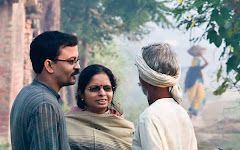http://
Student Blog #5: Inequality and the Caste System in India
...but there the laws of religion, the laws of the land, and the laws of honour, are all united and consolidated in one invariable system, and bind men [sic] by eternal and indissoluble bonds to the rules of what, amongst them, is called his [sic] caste.
Edmund Burke (1852:310)
Just the other day, the Starphoenix ran a story about a couple in India who were attacked with machetes for having married outside their caste. The wife remains in intensive care while the husband sadly succumbed to his wounds. Despite being caught on CCTV cameras the attackers remain at large (The Starphoenix 2016).
Discrimination based on caste – including prejudice against “untouchables” or “Dalits”, “backwards castes”, and other markers of difference based on descent – is a significant social justice issue in contemporary Indian society. Caste is a complex system of social stratification which allows for little, if any, possibility for social mobility outside of the particular caste into which one is born. According to Human Rights Watch (HRW) approximately 260 million people are affected by caste-based discrimination worldwide, most of whom reside in the South Asian countries of Nepal and India (HRW 2016). Low caste people regularly suffer discrimination in many forms, including perpetual extreme poverty, degrading and humiliating work, violence enacted by upper caste militias and police, and obstacles towards accessing education. Furthermore, women experience additional discrimination due to intersections between caste, gender, and poverty, which put them at even greater risk of sexual assault, forced sex work, violence and indignity through crimes from which the perpetrators walk with impunity (HRW 2016). Despite caste-based discrimination being rendered illegal under India's constitution since gaining independence from Britain in 1947, corruption within the justice system and ineffective bureaucracy makes filing complaints and seeing justice enacted remains prohibitively complex and ineffective for most people.
Last summer I had the opportunity to connect with a very interesting organization working to end caste-based discrimination in the villages surrounding the city of Varanasi, India. The Peoples' Vigilance Committee on Human Rights (PVCHR) was started in 1996 by Lenin Raghuvanshi and his wife Shruti Nagvanshi, along with musician Pandit Vikash Maharaj, poet Gyanendra Pati, and historian Mahendra Pratap. I was lucky enough to get to meet with Dr. Raghuvanshi for an afternoon to hear about his personal story and the projects in which the PVCHR are involved, and I was inspired by their breadth of scope and creative approaches to community-based social justice work.
What initially prompted me to seek out the PVCHR was a personal question that I had about the appropriateness of applying universal human rights – which I regarded as a Western construct – in non-Western cultural contexts. It is not that I was in any way in support of exploitation based on caste due to reasons of cultural relativism, but rather skeptical of the use of the language of human rights by aid organizations that apply western interpretations of human rights to developing countries. While there are certainly examples from the last six decades to suggest that human rights language can be mobilized for imperial purposes, my brief time at PVCHR helped to shift my thinking towards the possibility for social justice initiatives to use the language of human rights in an effective culturally attentive way through community based work.
Though textual evidence confirms that forms of the caste system have existed for hundreds of years in the Indian subcontinent, the contemporary form of right-wing Hindu nationalism which promotes casteism – known as the Hindutva movement as championed by the Rashtriya Swayamsevak Sangh (RSS) organization – was formed in the 1920s as a manifestation of British colonialism (The Kashmir Scenario 2014). Alternatively, PVCHR identifies tolerant, plural, and syncretic threads in Indian society throughout history, promoted by famous figures such as Kabir and Raidas in the 15th century. As such, the question of caste politics is open to change from within the society itself and to assert alternative forms of political, social, and religious identity against fascist political currents is by no means an imperial act, but is rather a radical act of social justice. Rauna Kuokkanen notes a semantic distinction, used by the International Indigenous Women's Forum (FIMI), between “harmful traditional practices” and “violence in the name of tradition”, which I think illuminates the realization that I experienced while listening to Dr. Raghuvanshi and other people at the PVCHR (Kuokkanen 2014:133).
While the work of the PVCHR began as an advocacy group for low-caste peoples it has grown to include intersectional initiatives working against neoliberal capitalism, nationalism, and fascism, towards supporting justice for women, Muslim minorities, children's rights to education and food, labour groups such as auto-rickshaw unions and weaver's cooperatives, and victims of police torture, to name a few (PVCHR 2011). The PVCHR are just one example of grassroots organizations around the world working to enact change where the official avenues fail to deliver justice to marginalized groups. While I remain skeptical about some of the “official” mobilizations of human rights discourse I believe that the language of human rights can offer a framework for grassroots social justice struggles.
- Thomas Seibel
References
Burke, Edmund. 1852. The Works and Correspondence of the Right Honourable Edmund Burke, Volume 7. London: Francis and John Rivington.
Human Rights Watch 2016. https://www.hrw.org/news/2016/
The Kashmir Scenario. April 13th, 2013. “The need of the hour is to create new dynamics and debate within India: Lenin Raghuvanshi”. URL: http://thekashmirscenario.com/
Kuokkanen, Rauna. 2014. “Confronting Violence: Indigenous Women, Self-Determination, and International Human Rights”, in Indivisible: Indigenous Human Rights. Joyce Green, ed. Fernwood Publishing: Halifax.
The Starphoenix. March 15th, 2016. “Graphic video shows Indian 'untouchable' hacked to death after marrying upper-caste woman”. URL: http://thestarphoenix.com/
PVCHR 2011. “Call for a neo-Dalit movement to overthrow feudalism, neo-fascism and neo-liberalism through a popular action”. URL: http://www.pvchr.net/2011/07/
#pvchr #leninraghuvanshi #lenin #u4humanrights






